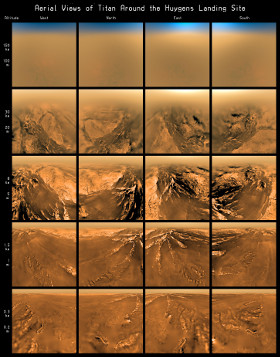Science highlights from Huygens:
#1. Profiling the atmosphere of Titan
Long before ESA's Huygens probe arrived at Titan, scientists knew that the moon's dense atmosphere was mainly composed of nitrogen, with some methane, but the atmosphere's structure – its temperature and pressure at different altitudes – was poorly understood.
 |
| Huygens's view of Titan from five altitudes. Credit: ESA/NASA/JPL/University of Arizona |
By monitoring the probe's rate of deceleration as it plunged into the atmosphere, the HASI instrument directly determined the density of the upper atmosphere. The temperature was derived from models of how it should change with density and altitude. In the lower atmosphere (below 160 km) and on the surface of Titan, HASI directly measured the pressure and temperature, as well as electrical properties such as permittivity and the distribution of ions.
HASI data showed that the upper atmosphere (the thermosphere) was generally warmer and more dense than expected. Titan's atmosphere was also found to be highly stratified.
Above 500 km, the average temperature was about
Below 500 km, the temperature increased quite rapidly, reaching a maximum of
The temperature increased again as the probe neared the surface, rising to a chilly




